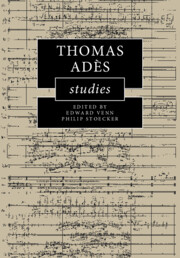16 results
Dedication
-
- Book:
- Thomas Adès Studies
- Published online:
- 18 November 2021
- Print publication:
- 25 November 2021, pp v-vi
-
- Chapter
- Export citation
Music Examples
-
- Book:
- Thomas Adès Studies
- Published online:
- 18 November 2021
- Print publication:
- 25 November 2021, pp xiii-xvi
-
- Chapter
- Export citation
Tables
-
- Book:
- Thomas Adès Studies
- Published online:
- 18 November 2021
- Print publication:
- 25 November 2021, pp xii-xii
-
- Chapter
- Export citation
Online Materials
-
- Book:
- Thomas Adès Studies
- Published online:
- 18 November 2021
- Print publication:
- 25 November 2021, pp xvii-xviii
-
- Chapter
- Export citation
Bibliography
-
- Book:
- Thomas Adès Studies
- Published online:
- 18 November 2021
- Print publication:
- 25 November 2021, pp 283-298
-
- Chapter
- Export citation
Notes on the Text
-
- Book:
- Thomas Adès Studies
- Published online:
- 18 November 2021
- Print publication:
- 25 November 2021, pp xxxi-xxxii
-
- Chapter
- Export citation
Copyright page
-
- Book:
- Thomas Adès Studies
- Published online:
- 18 November 2021
- Print publication:
- 25 November 2021, pp iv-iv
-
- Chapter
- Export citation
Contents
-
- Book:
- Thomas Adès Studies
- Published online:
- 18 November 2021
- Print publication:
- 25 November 2021, pp vii-ix
-
- Chapter
- Export citation
Preface
-
- Book:
- Thomas Adès Studies
- Published online:
- 18 November 2021
- Print publication:
- 25 November 2021, pp xxi-xxvi
-
- Chapter
- Export citation
Figures
-
- Book:
- Thomas Adès Studies
- Published online:
- 18 November 2021
- Print publication:
- 25 November 2021, pp x-xi
-
- Chapter
- Export citation
Index
-
- Book:
- Thomas Adès Studies
- Published online:
- 18 November 2021
- Print publication:
- 25 November 2021, pp 299-304
-
- Chapter
- Export citation
Contributors
-
- Book:
- Thomas Adès Studies
- Published online:
- 18 November 2021
- Print publication:
- 25 November 2021, pp xix-xx
-
- Chapter
- Export citation
5 - Chaconnes in the Music of Adès
-
-
- Book:
- Thomas Adès Studies
- Published online:
- 18 November 2021
- Print publication:
- 25 November 2021, pp 93-116
-
- Chapter
- Export citation
Acknowledgements
-
- Book:
- Thomas Adès Studies
- Published online:
- 18 November 2021
- Print publication:
- 25 November 2021, pp xxvii-xxx
-
- Chapter
- Export citation
Appendix
- from 2 - Performing Adès
-
- Book:
- Thomas Adès Studies
- Published online:
- 18 November 2021
- Print publication:
- 25 November 2021, pp 51-51
-
- Chapter
- Export citation

Thomas Adès Studies
-
- Published online:
- 18 November 2021
- Print publication:
- 25 November 2021



